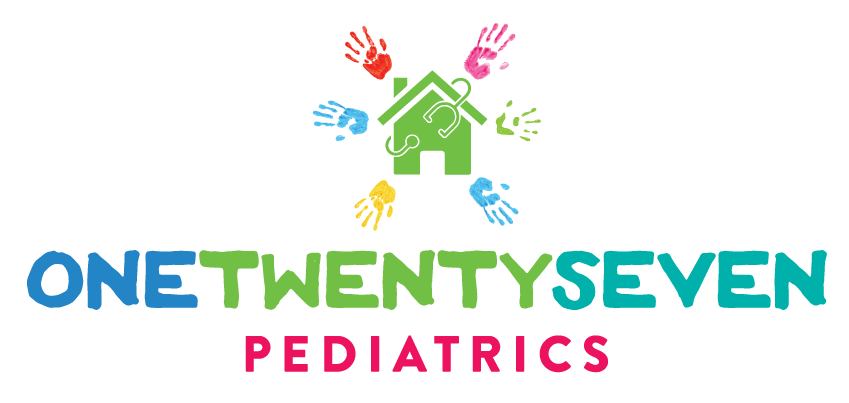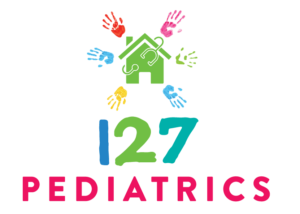Pediatricians diagnose and treat childhood constipation very frequently.
Almost daily.
We have a saying among our colleagues in our social media groups, “it’s always molluscum or constipation.”
While it may not be true that all childhood problems can be blamed on those two common diagnoses, constipation is such a frequent occurrence that it seems to be an inevitable part of childhood.
What is childhood constipation?
The definition of constipation is hard or infrequent stools.
Hard stools, bleeding bottoms, blood in the toilet or large stools are all evidence that your child is constipated.
What causes constipation?
Stool becomes hard and dry when the large intestine removes too much water from it as the mass moves through.
The colon (large intestine) normally removes water from human waste in order to make stool. Muscle contractions of the intestine move the stool toward the rectum. When it arrives, most of the water has been absorbed. Nerve endings in the rectum tell the brain that it is time to go to the bathroom and your child has the urge to stool.
Childhood constipation occurs if the large intestine removes too much water because the muscle movements are not pushing the stool through fast enough. Slow movements or motility leads to hard stools.
As soon as a child becomes constipated, many factors will quickly compound the problem. Dry and hard stools are very painful to push out. This causes your child to associate pooping with pain. Subsequently, they ignore their need to defecate.
With time, the nerve endings in the rectum will stop communicating to the brain that there is stool present that needs to be evacuated.
This leads to encopresis where liquid stool leaks around a hard mass of stool in the rectum. As you can imagine, this leads to all kinds of physical and social consequences for kiddos.
Know the Signs and Symptoms of Childhood Constipation
The signs and symptoms of childhood constipation are many and vary from child to child.
Your child may be constipated if they:
- Avoid going to the bathroom
- Are secretive about their bathroom habits or hide their underpants
- Leave “streaks” of stool in their underpants
- Complain of pain with pooping
- Evacuate large stools or have small “pebble” like stools
- Leak liquid stool into their clothes without their knowledge
- See blood on the toilet paper or in the toilet after stooling
- Urinate frequently or start wetting their pants after they have been potty trained for a period of time
- Don’t poop every day
- Complain of “tummy” pain, especially after meals
Risk factors for childhood constipation
Several risk factors exist that can lead your child to become constipated.
One huge risk factor for constipation is a low fiber diet. It is easy for young children to become rigid in their food choices. Often, they limit themselves to “bland white” foods that are low in fiber. Many children exist on chicken nuggets, white pasta and macaroni and cheese. Increasing fiber in your child’s diet can be difficult. However, it is worth the effort as it will not only help prevent constipation, but also promote good nutrition.
Toilet phobia is another common cause of constipation. I often hear from parents that their newly potty trained kids are almost always willing to urinate on the toilet, but have no desire to stool in the toilet due to fear. Using non-food rewards, reading a favorite book on the potty or simply just having scheduled potty sitting times goes a long way to decrease fears around this common childhood milestone.
Milk isn’t always good
Cow’s milk is a third common cause of childhood constipation. Whether or not your child has a sensitivity to cow’s milk protein or they are just consuming too much milk, this white liquid is guilty of creating many constipated kids. Large volumes of milk sitting in your child’s stomach causes them to be too full to eat other foods. This can lead to constipation (as well as iron deficiency anemia). Decreasing milk in your child’s diet or eliminating it completely for a period of time with help treat their constipation.
Milk has traditionally been a recommended part of a child’s diet. It is an easy way to get nutrients such a protein, Vitamin D and calcium into a child. However, if you give other foods that contain these nutrients, milk does not have to be a necessary part of your child’s diet. If you choose to give milk, don’t give more than 12-16 ounces in a day.
How do you treat childhood constipation?
While the causes of constipation in kids vary, there are several steps that parents can take to treat occasional constipation in their children. Increasing fiber in their diet, encouraging more water drinking and less milk all go a long way to keep things moving.
But, what if your child’s constipation is worse than occasional?
Childhood constipation is in the wheel house of your child’s pediatrician. If you need extra help, we are here for you and your child. I often use polyethylene glycol (or Miralax) to do a stool clean-out for chronically constipated children. The dose of PEG varies depending on the age of your child, but the safety of this medication is well proven.
This powder is known as an “osmotic laxative” because it draws water into the colon and therefore into the stool. It is a very well tolerated treatment for most children. I like this medication because it dissolves completely in liquid and even those most discerning of children don’t even know that it is in their beverage.
If you are doing a stool clean out, PLEASE, don’t mix the Miralax with a red or purple liquid. This will save your pediatrician from getting a panicked call about seeing blood in your child’s stool.
Sometimes, as a part of the stool clean out, kids will need help moving a hard stool from below. “Below” is also known as their rectum. This involves the use of an enema or suppository. Giving your child an enema is one of the most pleasant things that a parent can experience, aside from being barfed on.
Stool clean outs require weekends or days off in a row, so that your sweet constipated darling can run to the bathroom frequently. Your child’s teacher or daycare worker will appreciate your thoughtfulness in using your day off for this most favored task.
Prevention of childhood constipation
Whether you have treated your child for constipation or you are just hoping to prevent ever having to give your child an enema, there are some things that you can do at home.
- Timed toilet sitting time after meals
- take advantage of that gastro-colic reflex!
- Frequent potty breaks while playing
- Like Daniel Tiger says, “if you have to go potty, STOP! and go right away!”
- Feed your child fiber.
- Fruits with skin on.
- Vegetables blended in a smoothie.
- Chia seeds in their yogurt (if you are feeling lucky).
- Limit milk. Or just eliminate it all together.
- Friendly potty training
- patience, patience, and more patience.
- No punishments for accidents
- Water is your child’s friend.
- Allow your child to pick out a fun cup or bottle that is their “special” water cup
- Set water drinking goals (but nothing too aggressive)
- Use bribes (I mean, rewards).
Constipation stinks
Childhood constipation is one of the least exciting topics to talk about. However, it is a very common problem that many kids experience. Parents play a key role in preventing and treating constipation. Don’t forget that your pediatrician is also available to help you. We love talking about poop.
For more amazing insight on this topic, you can read my post about preventing constipation at different stage transitions.
© 127 Pediatrics, February 2022

Dr. Andrea Wadley is a pediatrician located in Dallas/Fort Worth serving families with pediatrician house calls. As a wife and mother, her posts are written with parents in mind, whether you need help with a picky eater, need to find places where kids eat free or want to know more about topics like breastfeeding and lactation.


